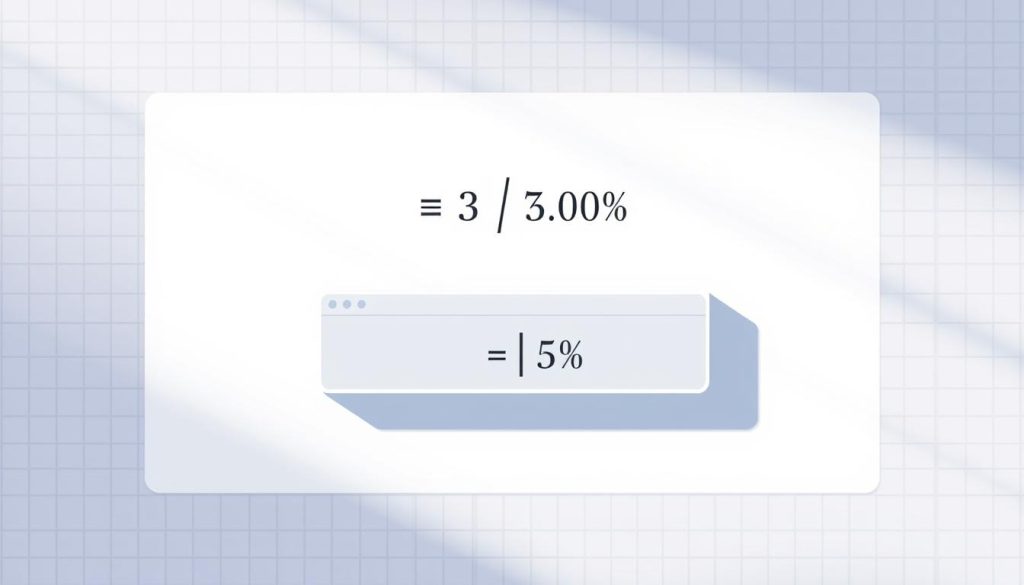Percent change is vital for grasping rate of change in finance, economics, and business. It helps track growth rates and analyze percentage variation precisely1.
The basic method compares an initial value to a final value. A simple formula determines the percentage increase or decrease between two points2.
Businesses use percent change to evaluate performance and track market trends. It’s crucial for analyzing stock prices, revenue growth, and customer metrics1.
Key Takeaways
- Percent change helps quantify relative differences between values
- The formula enables comparison across different scales and industries
- Understanding growth rate is essential for financial analysis
- Calculations work for both positive and negative value changes
- Percent change provides a standardized method of measuring variation
Understanding Percent Change Fundamentals
Percent change is a powerful math tool for analyzing differences and comparisons across various fields. It offers a standard way to grasp relative changes between two values. This makes complex number comparisons easier to understand3.
The idea of proportional difference helps track performance and evaluate growth. It turns number changes into percentages. This allows quick understanding of data shifts4.
Core Concepts of Percent Change
Percent change has key parts to understand:
- Measuring the difference between initial and final values
- Calculating relative change as a percentage
- Identifying trends and patterns in numerical data
Real-World Applications
Percent change calculations matter in many areas:
- Finance: Tracking stock performance
- Business: Analyzing revenue growth
- Economics: Monitoring inflation rates
| Domain | Percent Change Use |
|---|---|
| Stock Market | Evaluating investment returns |
| Retail | Measuring sales fluctuations |
| Personal Finance | Tracking budget changes |
When to Use Percent Change
Experts use percent change to:
- Compare values across different scales
- Normalize data for easier interpretation
- Identify significant variations in numerical trends
Percent change transforms raw numbers into meaningful insights that drive strategic decision-making.
How to Calculate Percent Change
Percent change is crucial for comparing values and tracking growth. It’s widely used in business and analysis. The formula helps measure performance changes over time.
- Subtract the original value from the new value
- Divide the result by the original value5
- Multiply the quotient by 100 to get the percentage
The formula is: Percent Change = ((New Value – Original Value) / Original Value) × 1005. This works for both increases and decreases in value.
Pro Tip: Always compare values within the same context for meaningful insights.
Let’s look at a real-world example. An employee’s hours increased from 35 to 45.5. The percentage increase would be 30%6.
This method helps track changes in various scenarios. It’s useful for business performance and economic indicators. A positive result shows an increase, while a negative one indicates a decrease5.
Mastering percent change calculations empowers you to make data-driven decisions. For more info, check out this guide on percent change calculations.
Conclusion
Calculating percent change is vital for understanding rate of change in various contexts. It provides valuable insights into growth and trends across professional and personal spheres. Investors can use this technique to evaluate asset performance and spot trading opportunities7.
The percent change formula is simple yet powerful. It helps track increases and decreases in different scenarios. This method offers a standard approach to understanding numerical shifts in various fields8.
Businesses can use percent change to track student attendance or miles driven. These metrics offer meaningful insights into growth rates. Practice is essential to master these calculations8.
Real-world applications show how versatile this analytical tool can be. You can learn more about percentage variation techniques through different examples. Regular practice will boost your confidence and precision in analysis.
Understanding percent change enables data-driven decision-making. It breaks down complex numerical relationships into digestible percentages. This skill helps gain deeper insights into performance, trends, and opportunities across various domains.
FAQ
What exactly is percent change?
How do I calculate percent change?
What’s the difference between a percentage increase and a percentage decrease?
Where is percent change most commonly used?
Can percent change be used in fields other than finance?
How do I handle negative percent changes?
Are there any tools to help calculate percent change quickly?
What are common mistakes to avoid when calculating percent change?
Source Links
- Calculate Percentage Change in Excel – https://corporatefinanceinstitute.com/resources/excel/calculate-percentage-in-excel/
- Percentage Change – https://www.mathsisfun.com/numbers/percentage-change.html
- Percent Change Formula: Meaning, Concept, Solved Examples – https://www.toppr.com/guides/maths-formulas/percent-change-formula/
- Percentage Change: Formula, Examples, How to Find Percentage Change – GeeksforGeeks – https://www.geeksforgeeks.org/percentage-change/
- 4 Methods to Calculate Percent Change in Excel – GeeksforGeeks – https://www.geeksforgeeks.org/how-to-calculate-percent-change-in-excel/
- Percentage Change – Percentage Increase and Decrease – https://www.skillsyouneed.com/num/percent-change.html
- How to Calculate a Percentage Change – https://www.investopedia.com/terms/p/percentage-change.asp
- Calculating Percent Change in 3 Easy Steps — Mashup Math – https://www.mashupmath.com/blog/calculating-percent-change
